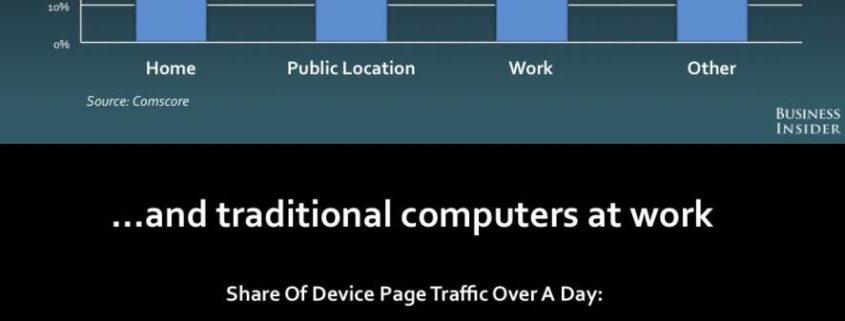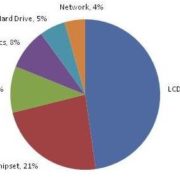This article is a second in a series. To read “Part I: It’s an iPad world, not Windows  8’s” and the article in full, click here.
8’s” and the article in full, click here.
The PC is not dead; it’s just not at home
With 300 million sales this year, it may be a bit premature to mourn the passing of PCs. What the decline in PC sales really signifies, some argue, is the death of the home desktop. Take a look at these Business Insider illustrations:
The view maintains that consumers only use desktops for work. The dominance of tablets and smartphones for personal use is a logical conclusion, if we assume that computers at home are strictly for entertainment.
People do other things on their home computers than post pictures and watch videos. Keyboards are an enormously attractive and useful interface, and despite predictions of their demise, I think they will persist. In The Death of Keyboards & the Japanese Experience, I examine the successful adoption of keyboards in Japan, despite the enormous obstacles:
“Consider the barriers to keyboard use that existed in Japan. There was a lack of ‘keyboard culture.’ The language is decidedly ‘keyboard unfriendly.’ Social attitudes stigmatized their use as lower class. An entire consumer electronics infrastructure existed that was independent of computers, and thus keyboards as well. Yet, as soon as it became practical, the Japanese adopted keyboards.”
If, despite all the impediments to its utilization, keyboards triumphed in Japan, it doesn’t seem likely that consumers in other countries will forgo them anytime soon.
An informed, but in many ways typical consumer, is Richard Barrios, AMREL’s web-marketing specialist. He currently owns a tablet, which is keyboard compatible, but the keyboard is small and uncomfortable to use. Right now he is wrestling with whether or not to buy an additional tablet or a traditional desktop PC. Tablets are cheaper, but he can’t do his taxes on them or pay the bills. Shopping on line is more difficult on a tablet, and his kids really need a full PC to visit the websites they need for homework. Even looking up movies is better on the traditional desktop, because the web pages are more complete and informative.
The PC rules
Marc Andreessen, co-author of Mosaic, the first popular graphic web browser, thinks the PC is far from dead. He feels that the combination of the web and a traditional PC platform is unbeatable. In an interview with Wired, he proposes a thought experiment:
“Let’s say we all grew up in tech world where we only used tablets and smartphones. Then one day, someone comes up to you with a 27-inch display hooked up to a notebook. You could have everything you have on your tablets and smartphones, and then some. Except you don’t have to download anything or update it.”
In addition to being a highly influential thought leader, Andreessen is a successful venture capitalist. He is backing up his words with appropriate investments.
There are fewer, but better PCs
There are 800 million PCs currently in use (install base). While people are using PCs, they are not actually buying them now. The reason they are not buying them is that they do not have to.
Writing in ZDNet, Simon Bisson points out that the failure of Vista meant that Microsoft could no longer count on Windows being a diver of PC sales. So, Microsoft adapted, and started producing better software that had a lower footprint. The changeover to Windows 7 did not require new hardware. A person could improve their computer’s performance with a software upgrade.
Another way of looking at this is that not only the software got better, but the hardware got better as well. Barrios, a long fixture in the IT community, recalls the “arms race” that use to happen between gaming programs and hardware.
“It used to be that if you wanted to play the latest game, you were forced to get new hardware. It was a race between software demanding more resources, and hardware providing them. In the old days software always won. However, software designers have failed to fully exploit the new multi-core platforms. Now, there is no need to buy a computer every time a new game comes out.”
As Bisson notes, “Fed up with planned obsolescence, we now demand things that last. How long did you keep your last washing machine, your vacuum cleaner, your last car?” Future Tense calls the new durability of computers, “unplanned non-obsolescence.”
It’s a software world
Software’s new role as the agent of improvement is only part of the story. Software has also become the main indicator of capabilities.
At AMREL, we are constantly customizing new solutions on our computers. One change that I have noted over the last several years is the prominence of software in the sales cycle. It used to be that when shopping for a computer solution, the first question an acquisition official would ask would be “What hardware should we use?” Now, whether it is a police IT manager looking for a Record Management System, or an ARMY procurement officer vetting a handheld biometric device or an electric company searching for meters to be used by field workers, the first question is usually “What’s the best software?” The most important quality of any hardware platform is software compatibility (not a problem for AMREL, because our computers are flexible and open-platformed).
Nowhere is this change more obvious than in the Warfighter Information Network-Tactical (WIN-T), the ARMY’s critical battlefield telecommunications program. For years, it was pointless to ask them what kind of mobile device soldiers were going to use; they had no idea. First, they would define the software. Then, they would buy the hardware.
Innovation exhaustion
However, the WIN-T program also illustrates another trend, which is related to the decline in PC sales. The US supports its military superiority by maintaining a technological edge. This requires constant innovation, which has become progressively more expensive, and some argue, less effective (see Why the future may not be a big deal in 2013 & how it will affect defense spending). The ARMY doesn’t even want to try to develop the latest mobile device. They want to be able to buy the latest hardware off-the-shelf, and deploy their software on it.
This is more than just using software as a means of upgrading performance. It’s an admission that the constant innovation and rapid rate of change that characterizes modern technology has become unsupportable. Virtually every institution (and person) in the world is under increasing stress trying to keep up with the latest change.
AMREL is very aware of this problem, since so many of our computers are used as part of larger solutions. We make a point of maintaining configuration stability, i.e. newer versions of our platforms, while improved, are roughly the same size and design as the old ones. This makes it easy to replace an old AMREL computer with a new one. Other companies have picked up on this, which is why you sometimes see ads that mention “future proofing.”
Even when change is as easy as downloading a new OS, people don’t want to do it. Sure, once you adjust to Windows 8, it’ll be fine to use, but who has the emotional energy to embrace change that you don’t really need? As long as your current computer and OS work OK, who needs the latest advance? As Bisson wrote, we are living in “The era of ‘good enough’ computing.”
Every once in a while I take my computer to the local repair shop. Inevitably, the repairman says, “You need X, Y, and Z.” Inevitably, I respond with, “But I just bought a new X, Y, and Z six months ago!” He smiles, and replies, “You are not done paying for the computer revolution.”
Maybe not, but the decline in PC sales indicates that millions of consumers like myself are putting the future on hold.
Any questions or comments, please write to editor@amrel.com.








